Despite their apparent simplicity, bends are often poorly understood, and unless properly designed, they are potentially problematic
Pneumatic conveying of bulk solids has been successfully practiced — in industries as diverse as chemical, agricultural, pharmaceutical, plastics, food, mineral processing, cement and power generation — for more than a century. Pneumatic conveying provides advantages over mechanical conveying systems in many applications, including those that require complex routing, multiple source-destination combinations and product containment.
Pneumatic conveying transfer lines are often routed over pipe racks and around large process equipment, giving process operators great layout flexibility. Such design flexibility is made possible by the use of bends (such as elbows and sweeps, discussed below) between straight sections (both horizontal or vertical), which enable convenient change of direction in the flow of the conveyed solids.
However, among all the components of a pneumatic conveying system, bends — despite their apparent simplicity — are probably the least understood and most potentially problematic for process operators. Findings from various research studies are often not consistent, and often times public findings do not match field experience.
The importance of bends in any pneumatic conveying assembly cannot be overstated since — if not properly selected and designed — they can contribute significantly to overall pressure drop, product attrition (degradation) and system maintenance (due to erosive wear).
Historically, a basic long-radius bend (Figure 1) has been the bend of choice for designers of pneumatic conveying systems, for a variety of reasons:
-
Long-radius bends provide the most gradual change in direction for solids, and hence are most similar to a straight section of piping
-
The angle of impact on the pipe wall is relatively small, which helps to minimize the risk of attrition or erosion
-
For lack of other experience, to maintain the status quo
Years of field experience and a variety of studies conducted to troubleshoot common problems — such as line plugging, excessive product attrition (degradation), unacceptably high bend wear and higher-than-expected pressure drop — clearly indicate that the flow through bends in pneumatic piping is very complex. One should refrain from generalizing the findings until the underlying physics are well understood.
This complexity is exacerbated when innovative designs are introduced to address existing issues with common-radius bends (also discussed below). Today, most of the data still resides with vendors and there is a need for fair, unbiased and technically sound comparative evaluation.
The purpose of this article is to summarize the key concepts, outline key metrics used to evaluate bend performance, and provide guidance for their selection. The discussion is limited to dilute-phase conveying.
BEND DESIGNS
Bends are installed in a pneumatic conveying system wherever a change in direction is required along the conveying route. They can be broadly classified into three major categories:
-
Common-radius bends (including elbows, short-radius, long-radius and long-sweep bends)
-
Common fittings (including tee bends, mitered bends and elbows)
-
Specialized bends and innovative designs (such as the Gamma Bend, Hammertek Smart Elbow, Pellbow, wearback designs, and lined bends, which are described below)
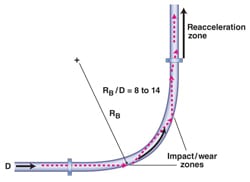 |
| Figure 1. Flow in a standard, long-radius bend is illustrated here, with typical flow patterns, wear points and reacceleration zone shown |
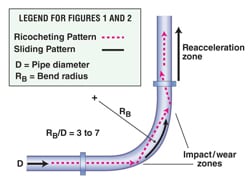 |
| Figure 2. Flow in a standard, short-radius bend is illustrated here, with typical flow patterns, wear points and reacceleration zone shown |
Common-radius bends
Common-radius bends (Figures 1 and 2) are made by bending standard tubes or pipes. The radius of curvature ( R B) may range from 1 to 24 D (where D is the diameter of the tube or pipe). Common-radius bends can be loosely classified as follows:
Elbow: RB /D = 1 to 2.5
Short radius: RB /D = 3 to 7
Long radius: RB /D = 8 to 14
Long sweep: RB /D = 15 to 24
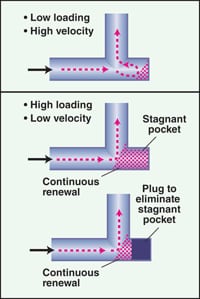 |
| Figure 3. The effect of loading and gas velocity on flow patterns in a blind tee (horizontal-vertical orientation) is shown here |
These bends are available in a wide range of materials of construction and thicknesses, similar to the straight section of pipe (tangent) that is provided on either side of the curved section. The conveyed material may undergo multiple impacts with the pipe wall, or may slide along the outer radius, depending on material properties, solids loading (defined as mass of solids/mass of air) and gas velocity. Bend wear and material attrition commonly occur at the impact zones.
Common fittings
The most commonly used fitting to accomplish a change in flow direction is a blind tee bend. In this design, one of the outlets is plugged thereby allowing conveyed solids to accumulate in the pocket (Figure 3). The benefit of this design is that the accumulated pocket of material cushions the impact of the incoming material, significantly reducing the potential for wear and product attrition. The extent of accumulation in the pocket will depend on the orientation of the bend, solids loading, gas velocity and material properties (such as particle size and cohesiveness).
However, in a tee bend, the conveyed solids lose most of their momentum during the impact and thus must be reaccelerated downstream of the bend. As a result, pressure drop across a blind tee can be as much as three times that of a long-radius bend. Several variations of common fittings are shown in Figure 4.
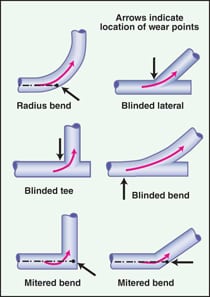 |
| Figure 4. Several variations of common fittings are provided here, with typical wear points highlighted |
Specialized bends
Today, a variety of specialized designs are available to control flow within the bend, in order to minimize attrition and wear. This is often achieved by creating a self-cleaning or replenishing pocket or layer of material, upon which the incoming stream impinges. Wear inside the piping is minimized by redirecting the gas-solid suspension away from typical wear points. Several of the most commonly used specialized bends are discussed below.
Proprietary designs. The Gamma Bend from Coperion (coperion.com) is shown in Figure 5. Its innovative design relies on creating particle-particle impact in the impact zone and prevents sliding motion of particles along the outer radius to minimize particle smearing, so it is especially effective in preventing the formation of streamers (also known as floss or angel hair) in polymer pellets. A minimum solids loading is required to ensure accumulation of material in the impact zone. In the absence of this layer, the particles will directly impact the target plate within the bend and may result in both particle attrition and pipe erosion. (A typical recommendation for minimum solids loading is 5, but it depends on the bulk density of the product.) Gamma Bends are typically fabricated from stainless steel, and provide a very tight bend radius ( R B/ D = 4 to 6). The pressure drop is higher (20 – 30%) than that experienced by a typical short-radius bend ( R B/ D = 3 to 7).
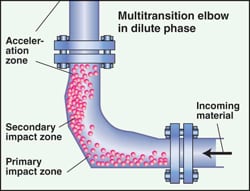 |
|
Figure 5. In the Gamma Bend design,
|
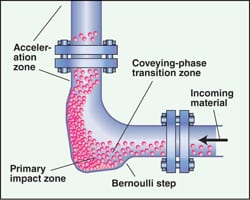 |
| Figure 6. The formation of a pocket of ma- terial at the primary impact zone helps to min- imize attrition and erosion in a Pellbow bends |
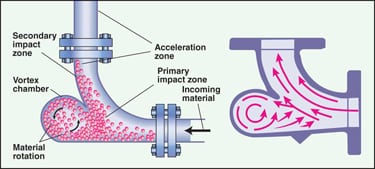 |
| Figure 7. In a Vortice Ell or Hammertek Smart Elbow bend, a bulbous extension creates a circulating flow pattern or a pocket of material, which cushions the impact on incoming stream |
The Pellbow Bend from Pelletron Corp. (pelletroncorp.com) is shown in Figure 6. It is similar to a short-radius bend but has an expanded pocket. The pocket is meant to accumulate a small amount of solids at the primary impact location so that most of the impact is between particles themselves. To ensure adequate accumulation of material in this pocket, the minimum recommended solids loading is typically 3, but it depends on bulk density and particle size. According to the vendor, pressure drop will be slight higher than that experienced by a short-radius bend. A wide range of materials of construction are available.
The Vortice-Ell Smart Elbow from Rotaval (rotaval.co.uk) and the Hammertek Smart Elbow from Hammertek Corp. (hammertek.com) are similar in design (Figure 7). Both have a bulbous extension on the heel. Depending on the orientation and inlet gas velocity, the incoming material will either fill the chamber or circulate within the chamber before exiting. In either case, it results in significant reduction in wear and attrition of material. It is available in 45- and 90-deg. designs and in various materials of construction.
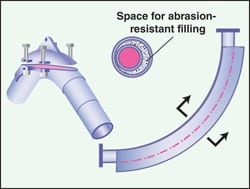 |
| Figure 8. A wearback elbow design can either be a replaceable hardened piece or a wearable inner core with abrasion-resistant filling |
Wearback designs. There are two major types of wearback elbow designs (as shown in Figure 8):
-
Elbows equipped with a wear plate with a sacrificial and replaceable back plate:
-
The replaceable back plate is made from hardened material, typically with Brinell hardness greater than 400 (similar to that of Ni)
-
Models are typically available with short-radius designs (RB/ D = 2 to 6) and multiple angles 22.5, 45, 60 and 90 deg.
-
Segmented designs are available, which allows for partial replacement of the elbow body
-
This design is commonly used in the flyash industry
-
-
Tube-in-tube (pipe-in-pipe) type:
-
The space between the inner and outer casings can be left unfilled or filled with concrete or porcelain or another abrasion-resistant material
-
For the unfilled design, once the inner core wears out, the product fills the cavity. Thereafter, the material impacts on a packed bed, which continuously gets replenished. This design is not suitable for abrasive products that tend to degrade, or where cross-contamination is a concern
-
For the filled design, once the inner core wears out, the abrasion-resistant filling provides a longer bend life compared with many regular bends
-
Bends with liners. Bends with abrasion-resistant liners are used for highly abrasive products. A wide range of proprietary lining materials are available. Examples include high-density alumina ceramics, zirconium corundum, hardened cast iron, silicon carbide and tungsten carbide. The presence of a liner also extends the upper limit of the operating temperature for the bend component.
BEND PERFORMANCE
A variety of metrics are helpful in evaluating bend performance in pneumatic conveying systems, including the following:
-
Pressure drop related to the bend
-
Attrition or product degradation
-
Wear, erosion or bend life
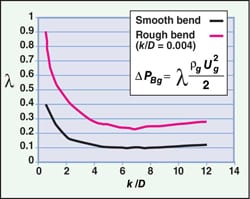 |
| Figure 9. Shown is the effect of bend geometry and internal pipe roughness on the number of velocity heads (λ) for bend pressure drop |
Pressure drop
Single-phase flow of a fluid through a bend (or any component causing directional change) will result in additional pressure drop. This behavior is well understood and reported [ 2]. The pressure drop in a bend depends on the ratio of bend radius to pipe diameter (RB/D), the gas velocity (Ug) and the internal roughness (k) of the pipe (Figure 9).
When a two-phase, gas-solid suspension undergoes a directional change, such as in a bend, the bend naturally acts as a segregator or separator of the two phases. Due to the centrifugal forces acting on the particles, they are concentrated along the outer wall of the bend. For instance, in the case of fine coal, an unusual phenomenon of roping (the formation of concentrated strands) is observed. Depending on material properties, solids loading, gas velocity and pipe-wall interactions, the particles may have multiple impacts within the body of the bend.
As a result of particle-particle and particle-wall impacts and the friction along the pipe wall, the particles exit the body of the bend at a velocity that is lower than their steady-state velocity. The particles must re-accelerate to their steady-state velocity after they exit the bend. The steady-state velocity for horizontal flow of a gas-solids suspension is typically in the range of 70 – 90% of the gas velocity. The energy required for reacceleration manifests itself as additional pressure loss after the bend, and the extent of the pressure drop depends on the extent to which the solids have been slowed during the transit.
Simply put, the pressure drop due to a bend in gas-solid flow is due to the combination of frictional loss in the bend itself plus the energy required to reaccelerate the solids back to the steady state velocity. It should be noted that the friction coefficient within the bend will be different than the corresponding friction coefficient in an adjacent straight section. Meanwhile, additional losses due to static head (such as in horizontal-vertical and vertical-horizontal orientation) are usually minor but must also be considered.
The pressure drop in a bend is most accurately quantified if the static pressures along the conveying line are measured before and after the bend location (see Figure 10). The static pressure decreases linearly in the straight section preceding the bend. The pressure gradient increases in the body of the bend and continues to be non-linear even after the flow exits the bend. It may take considerable distance downstream of the bend (up to 15 – 20 ft; 5 – 6 m) for the flow to reach steady state pressure and for the gradient to become linear again.
 |
| Figure 10. This static pressure profile in a bend region shows the pressure gradient in the bend and in the reacceleration region |
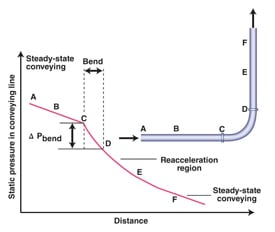 |
| Figure 11. This inaccurate pressure-drop measurement does not account for the reacceleration region |
The pressure drop incurred by a bend can be correctly estimated by extrapolating (in the upstream direction) the linear pressure gradient downstream of the bend until the imaginary outlet of the pipe bend (D*, Figure 10). As shown in Figure 11, by comparison, if two pressure taps are placed just across the body of the bend at locations C and D, an incorrect estimation of pressure drop would be made. This is a common mistake that leads to much confusion in the literature.
Calculation of bend pressure drop (EEUA). A simple approach to estimate the pressure drop resulting from standard radius bends was proposed in “EEUA Handbook” [ 7]. The bend coefficient ( B) can be estimated by regression using actual data. In the absence of experimental data, use the values given in Table 1.
![]()
Where
ΔPB = Total pressure drop due to a radius bend
B = Bend loss coefficient
µ = Solids loading (mass of solids / mass of conveying gas)
ρg = Gas density at bend location
Ug = Superficial gas velocity at bend location
Equivalent-length approach. An alternate approach to represent the pressure drop due to a bend is to quote an equivalent length of straight section that would result in the same pressure drop as the bend in question. The total effect of bends on system pressure drop can be estimated by multiplying the number of bends by equivalent length, and adding it to the total length of straight sections (horizontal and vertical). An equivalent length of 20 ft (6 m) is a good first guess. This approach is practical and easy but difficult to generalize for new materials.
Qualitative comparison of bend pressure drop. Combining published data and practical experience, we have compiled a ranking for various types of available bends based on pressure drop characteristics (Table 2). Note that in certain instances, the difference in pressure drop between tee bends and short-radius elbows can be insignificant, as some studies have suggested. Also, excess pressure drop in long-sweep bends may be attributed to their greater overall physical length.
Various factors affecting bend pressure drop are summarized in Table 3.
It is important to consider the pressure drop contribution of the bends in the perspective of the overall system pressure drop. The total contribution of bends to the overall system pressure drop will depend on the number of bends per unit length. If their contribution is relatively small, then replacing one type of bend with another will make little difference to the overall pressure drop (or on the conveying capacity). One must then select the bends based on other attributes.
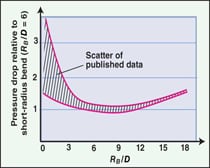 |
| Figure 12. Shown here is the effect of bend curvature on pressure drop in pneumatic conveying bends |
Despite numerous studies on bends and the presence of large amounts of operating data, there is still confusion and disagreement on pressure drop that is attributable to various bend geometries (as shown in Figure 12). Reasons for such confusion include the following:
-
The techniques for measurement and data analysis are not standardized. Some studies use the static pressure profile approach described above, while others estimate pressure drop due to bends by swapping one bend type with the other
-
It is not possible to critically evaluate all the studies since details are not always available
-
Most studies are done on systems with multiple bends and fail to account for the effect of location and interaction between the bends due to insufficient straight sections between them
-
It is difficult to generalize the results since individual studies often focus on few materials and limited range of operating conditions (such as solids loading, gas velocity, orientation)
-
Large-scale test data sets are very few. Most studies are conducted on pilot-scale systems
| R B / D | B |
|---|---|
| 2 | 1.5 |
| 4 | 0.75 |
| ≥ 6 | 0.50 |
| Bend type | Ranking for pressure drop |
|---|---|
| Long sweep | 6 (highest) |
| Blind tee | 5 |
| Vortice Ell or Hammertek Smart Elbow | 4 |
| Mitered bend | 3 |
| Gamma Bend or Pellbow | 2 |
| Short-radius and long-radius bend | 1 (lowest) |
| Factor affecting bend pressure drop | Effect on bend pressure drop with increase in value of factor |
|---|---|
| Gas velocity at bend inlet | ↑ |
| Solids flowrate (at constant gas velocity) | ↑ |
| Particle elasticity | ↑ |
| Particle size | ↓ |
| Pipe roughness | ↑ |
| Radius bend: RB/ D (1 – 24) | ↓ ( RB/ D ≤ 12) ↑ ( RB/ D >12) |
Attrition or particle degradation
The attrition or degradation of materials during pneumatic conveying is a significant concern to the industry. Attrition generally refers to the formation of “unwanted” fractions or species in the conveyed material, which may adversely affect its value.
Attrition or product degradation can manifest itself in various ways:
-
Change in particle size and shape distribution
-
Surface abrasion of particles resulting in a loss of gloss
-
Degradation of product due to impact heating
-
Smearing on the wall, which can result in cross-contamination
-
Undesirable loss of surface coating or additives
Generation of fines due to breakage, chipping or surface abrasion can also create downstream processing issues, such as dusting, poor flowability and increased caking tendency. It may also lead to increased potential for dust explosion or increased exposure to respirable dust.
During pneumatic transport of bulk solids, particles undergo multiple impacts on the pipe wall, especially at the bends. The key parameters affecting particle attrition during pneumatic conveying are summarized below.
Process-related factors:
-
Mode of conveying (dense versus dilute phase)
-
Gas velocity or particle velocity
-
Solids loading (or concentration)
-
Temperature of gas and solids (coupled with material properties)
-
Conveying distance
-
Materials of construction of straight pipeline sections and bends
-
Surface finish of pipeline and bends
-
Number of bends (frequent change in direction)
-
Bend geometry and flow pattern at the bend
Material-related factors:
-
Particle size
-
Particle shape
-
Particle strength or modulus or Vicker’s hardness
-
Elasticity of particles
-
Breakage function of material
Attrition and degradation issues impact bend performance in several ways:
-
Attrition in tee bends will be low if the primary mechanism of breakage is particle fracture due to impact loading. In tee bends, the particles are essentially impacting on a loose bed of accumulated material, which acts like a cushion. However, if the process conditions do not result in the formation of a suitable bed (for instance, the stream velocity is too high, or solids loading is too low), then particle attrition can still be significant
-
Attrition in short-radius bends or elbows is generally high due to impact on the bend wall
-
Attrition in long-radius bends or long-sweep bends can be high if chipping or surface abrasions are primary mechanisms. Multiple impacts or ricocheting inside the bend can aggravate the problem
-
Attrition in specialized transition designs, such as the Gamma Bend, or Pellbow (discussed above), tends to be low, as long as material accumulation occurs in the transition cavity. Overall performance will depend on the orientation of the bend
The specific definition of attrition varies with the application and the product being conveyed. For agricultural products, attrition may refer to damaged or split grains, whereas for polymer pellets, attrition often manifests itself as polymer dust, chips or streamers during conveying.
Based on our experience, we recommend the following measures to mitigate attrition in existing pneumatic conveying systems:
-
Reduce conveying velocity or increase the solids-loading ratio
-
Reduce the number of bends by simplifying the line layout wherever possible
-
Replace bends with designs that are less prone to attrition
Bend wear and erosion
Each time the particles impact the pipe and bend walls, energy is transferred to the point of impact. Depending on the comparative strength of particle and wall materials, either the particle is damaged (attrition) or the pipe/bend wears out.
There are numerous ways to quantify and analyze the wear data. For instance, in research studies, wear may be characterized by erosion rate (total mass of bend eroded), specific erosion rate (mass of bend eroded per unit of mass of conveyed material), penetration rate (depth of penetration per unit mass of conveyed material) and bend life (time required to lose containment).
| Bend type | Advantages | Disadvantages |
|---|---|---|
| Blind tee |
|
|
| Blind radius bend |
|
|
| Blind lateral |
|
|
| Mitered bend |
|
|
| Elbow ( R B/ D < 3) |
|
|
| Radius bend: Short radius ( R B/ D = 3 – 7) |
|
|
| Radius bend: Long radius ( R B/ D = 8 – 14) |
|
|
| Radius bend: Long sweep ( R B/ D = 15 – 24) |
|
|
| Radius bends with liners |
|
|
| Radius bend with wearable backing |
|
|
| Radius bend with internal baffles |
|
|
| Short-radius bends with pocket for material (Vortice Ell, Hammertek Smart Elbow) |
|
|
| Transition designs (mitered, expansion-cavity and flow-redirection, such as the Gamma Bend, Pellbow) |
|
|
| Rubberized or flexible bends |
|
|
While the conclusions reached depend on the applied metric, there is general agreement that the major factors associated with erosion in bends are as follows:
Bend geometry: This affects the number and location of impact zones.
Orientation: Orientation affects the location of impact zones.
Flow pattern inside bend: This determines the penetration rate and uniformity of wear.
Material of construction (hardness): Erosion rate is inversely proportional to the hardness of bend material.
Particle hardness: Erosion rate is proportional to particle hardness.
Particle size and shape: Three phenomena are noteworthy:
-
Specific erosion rate increases with particle size until a critical particle size, then the rate does not change
-
Bend failure due to penetration occurs faster with smaller particles
-
Angular particles will increase erosion rate
Conveying velocity: The specific erosion rate is a strong function of gas velocity ( Ug2.5 to Ug4).
Particle concentration: Significant reduction in specific erosion rate occurs at higher particle concentrations (due to greater cushioning effect).
From a wear standpoint, bends can be classified into three groups:
-
Class I (most resistant to erosion): Blind tee, Vortice Ell or Hammertek Smart Elbow, Pellbow, radius bends with abrasion-resistant liners, wearback designs
-
Class II (medium resistance to erosion): Mitered bend, Gamma Bend, long sweep
-
Class III (very susceptible to erosion): Common-radius bends (short and long)
It should be noted that significant wear can sometimes be observed in the straight section downstream (up to 10 pipe diameters) of a bend depending on the flow pattern within the bend.
| Bend type | Cohesive or sticky or moist | Fragile or friable solids | Hard and abrasive solids | Soft and rubbery solids | Product purity required / no cross contamination |
|---|---|---|---|---|---|
|
S = Suitable S* = Suitable under certain conditions NS = Not Suitable NR = Not Required |
|||||
| Blind tee | NS | S* | S | NS | NS |
| Blind radius bend / blind lateral | NS | S* | S | NS | NS |
| Mitered bend (90-deg. turn) | NS | NS | NS | S | S |
| Elbow (R B /D < 3) | NS | NS | NS | S | S |
| Radius bend: Short radius (R B /D = 3 – 7) | S | S* | NS | S | S |
| Radius bend: Long radius (R B /D = 8 – 14) | S | S* | NS | S | S |
| Radius bend: Long sweep (R B /D = 15 – 24) | S | S* | NS | S | S |
| Radius bends with liners | S* | NR | S | NR | S |
| Radius bend with wearable backing | S | NR | S | NR | S* |
| Radius bend with internal baffles | NS | NR | S | NS | NS |
| Short-radius bends with pocket for material (Vortice Ell, Hammertek Smart Elbow) | NS | S | S | NR | S* |
| Transition designs (Gamma Bends) | NS | S | NS | S | S |
| Transition designs (Pellbow) | NS | S | S | S | S |
| Rubberized or flexible bend | S | S* | S* | NR | S* |
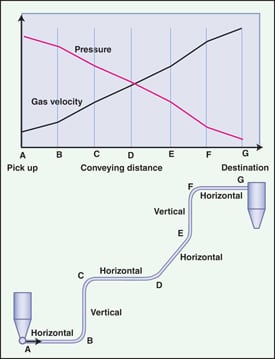 |
| Figure 13. Gas velocity increases as the pressure in the system decreases from pickup to destination. The local gas velocity at each bend will depend on its location |
BEND LOCATION
Regardless of the type of conveying system (pressure or vacuum) or the mode of conveying (dense or dilute phase), the pressure always decreases from pickup location to destination. As dictated by the Ideal Gas Law, the gas velocity will proportionally increase from pick up location to the destination (see Figure 13). Therefore, any bends located toward the end of the conveying system will experience velocities (gas and particle) that are higher than those closer to the pickup location.
Since pressure drop, attrition and erosion are all strongly affected by gas and particle velocity, bends that are of similar geometry but located toward the end of the system will incur higher pressure loss, and thus will experience greater attrition and wear. It should be noted that the solids loading (mass of solids/mass of air) in the entire system remains constant, and does not depend on the location.
Pressure versus vacuum mode
The increase in gas velocity (from pick up to destination) is greater when the system is operating in pull mode (vacuum system) versus push mode (pressure system). A simple set of calculations (assuming isothermal conditions), shown below and referring to Figure 13, highlights the point.
As can be seen, the velocity at the exit (at location G) for a vacuum system is 42% higher than that for a pressure system. Therefore, a higher level of attrition and wear can be expected in a vacuum system, as compared to that expected in a pressure system with similar layout and overall pressure drop.
Pressure system (push mode):
Conveying pressure (at location A) = 8 psig (55.1 kPa gage)
Pick up velocity (at location A) = 4,000 ft/min (20.3 m/s)
Pressure in the destination receiver = 0.05 psig (0.35 kPa gage)
Velocity at the exit (at location G) = 6,177 ft/min (31.4 m/s)
Vacuum system (pull mode):
Conveying pressure (at location A) = 0 psig = 14.7 psia (101.3 kPa abs)
Pick up velocity at location A) = 4,000 ft/min (20.3 m/s)
Pressure in the destination receiver = – 8 psig = 6.7 psia (46.2 kPa abs)
Velocity at exit (at location G) = 8,776 ft/min (44.6 m/s)
SELECTION OF BENDS
The following key issues must be considered while selecting bends for pneumatic conveying applications:
Type of conveying: Dilute versus dense phase
Product characteristics:
-
Particle size and shape
-
Particle hardness (erosive wear)
-
Attrition or fines generation
-
Cohesiveness / stickiness
Process requirements:
-
Free of cross-contamination
-
Minimization of pressure drop or power consumption
-
Layout constraints
-
Consequences of wear or material leakage to environment
-
Minimize fines generation or product degradation
-
Materials of construction
-
Minimize downtime (frequency of replacement)
Industry-specific practices: Consider, for instance, that the use of a smooth radius bend with polyolefin pellets can result in formation of streamers.
The purchase cost of a bend and its geometry (which affects the layout of the process) has a direct impact on the cost of any pneumatic conveying project. It is prudent to consider the long term cost of ownership of a bend. For instance, a low-cost bend that results in product degradation or higher energy cost due to increase pressure drop will be more expensive in the long run.
Table 5 summarizes the suitability of competing bends, based on product characteristics.
INSTALLATION GUIDANCE
By following these recommendations, process operators can minimize problems associated with bends in pneumatic conveying systems.
-
Minimize the number of bends in the transfer system
-
Do not install a long-radius bend (horizontal to vertical) within 20 ft (6 m) of the pick up location
-
Back-to-back bends are not advisable. Avoid three bends in close proximity, if possible
-
More bends toward the end of the transfer will increase pressure drop, erosion and attrition. Consider directional changes earlier in the layout, if possible. Consider stepping up the line size, if the pressure ratio permits, to minimize the velocity toward the end of the system
-
Misaligned bends will increase attrition and wear
-
Install critical bends such that they can be easily serviced (accessible and replaceable)
-
Consider insulating pipe and bends when noise is an issue (especially indoors) or select appropriate type of bends. For outdoor installations, insulation can reduce the tendency of the material (such as plastic pellets) to smear inside the bend
-
Pay close attention to the direction of flow in specialized bends during installation
Final thoughts
Bends are a critical aspect of any pneumatic conveying system layout, and proper selection is a critical aspect of system design and operation. Improper selection of bends can result in conveying capacity limitations (due to excessive pressure drop), high product degradation/attrition, and high wear rates, which can create additional maintenance, safety and environmental issues.
Optimal longterm cost of ownership can be achieved if the product characteristics and process constraints are more appropriately matched. A thorough evaluation often reveals that specialized bends may not be the best option.
Available information on pipe bends in the open literature can be confusing, and these findings often conflict with field experience. Industry need to continue studying various aspects of pneumatic flow using modern tools for flow visualization and computational fluid dynamics for modeling.
Edited by Suzanne Shelley
Acknowledgements
The authors would like to thank Paul Wagner, Pelletron Corp., for his comments and suggestions.
References
|
Authors
|
 Shrikant V. Dhodapkar is a technical leader in the Dow Elastomers Process R&D Group at The Dow Chemical Co. (Freeport, TX 77541; Phone: 979-238-7940; Email:
Shrikant V. Dhodapkar is a technical leader in the Dow Elastomers Process R&D Group at The Dow Chemical Co. (Freeport, TX 77541; Phone: 979-238-7940; Email:  Paul Solt has been involved in pneumatic conveying since 1950, currently as a consultant with Pneumatic Conveying Consultants (529 S Berks Street Allentown, PA 18104; Phone: 610-437-3220; Email:
Paul Solt has been involved in pneumatic conveying since 1950, currently as a consultant with Pneumatic Conveying Consultants (529 S Berks Street Allentown, PA 18104; Phone: 610-437-3220; Email:  George E. Klinzing is professor of chemical engineering and vice-provost for research at the University of Pittsburgh (826 CL University of Pittsburgh, Pittsburgh, PA 15260; Phone: 412-624-0784; Email:
George E. Klinzing is professor of chemical engineering and vice-provost for research at the University of Pittsburgh (826 CL University of Pittsburgh, Pittsburgh, PA 15260; Phone: 412-624-0784; Email: